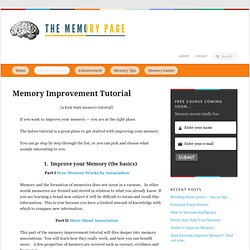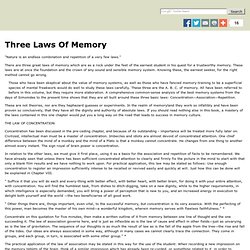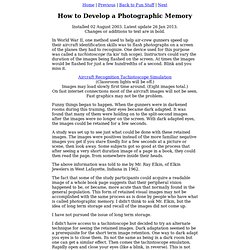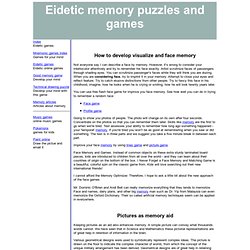

Help.
Accelerated Learning. The Open University. CAL. Memory Improvement Techniques - Improve Your Memory with MindToo. © VeerPRZEMYSLAW PRZYBYLSKI Use these techniques to improve your memory. The tools in this section help you to improve your memory. They help you both to remember facts accurately and to remember the structure of information. The tools are split into two sections. Firstly you'll learn the memory techniques themselves. As with other mind tools, the more practice you give yourself with these techniques, the more effectively you will use them. Mnemonics 'Mnemonic' is another word for memory tool. BUILDYOURMEMORY.COM / A mnemonics and memo. Tutorials: Begin Improving Your Memory.
(a kick-butt memory tutorial) If you want to improve your memory — you are at the right place.

The below tutorial is a great place to get started with improving your memory. You can go step by step through the list, or you can pick and choose what sounds interesting to you. Mindmap. The definitive collection of idea generation methods. MindGenius Business - Impressive Mind Mapping Software - Innovat. Software for Visualizing and Managing Information. Map Library. Simple Knowledge Organisation Systems (SKOS) - home page.
SKOS is an area of work developing specifications and standards to support the use of knowledge organization systems (KOS) such as thesauri, classification schemes, subject heading lists and taxonomies within the framework of the Semantic Web ...

[read more] Alignment between SKOS and new ISO 25964 thesaurus standard (2012-12-13) ISO 25964-1, published in 2011, replaced the previous thesaurus standards ISO 2788 and ISO 5964 (both now withdrawn). Members of the Working Group responsible for ISO 25964 have gone on to consider the implications for SKOS users. They have developed a set of linkages between the elements of the ISO 25964 data model and the ones from SKOS, SKOS-XL, and MADS/RDF. From Chaos, Order: SKOS Recommendation Helps Organize Knowledge (2009-08-18) Call for Review: SKOS Reference Proposed Recommendation (2009-06-15) The Semantic Web Deployment Working Group has published the Proposed Recommendation of SKOS Simple Knowledge Organization System Reference. FreeMind. FreeMind is a premier free mind-mapping software written in Java.

The recent development has hopefully turned it into high productivity tool. Research Publications Associated with CmapTools. Collaboration - Description of Collaboration in Cmap. Concept Mapping Resource Guide. General Reading.

A good place to start learning about concept mapping is by doing some reading of the primary background articles. Here are some of the "classic" articles that are a good starting point: Web Page Introductions. There are also several good introductory web pages available for the beginner: There are two major websites that act as major resources on concept mapping: Concept Systems Incorporated This is, of course, the primary website and the only one from which you can download the software and obtain information about licensing and training.
Presentations. Introduction to Concept Mapping Presentation in San Diego, January 13, 2005. Knowledge Base and Online Help. Tutorial. Training. CreatingMinds - tools, techniques, methods, quotes on creativity. Three Laws Of Memory. "Nature is an endless combination and repetition of a very few laws.

" There are three great laws of memory which are as a rock under the feet of the earnest student in his quest for a trustworthy memory. These laws are at once the foundation and the crown of any sound and sensible memory system. Knowing these, the earnest seeker, for the right method cannot go wrong. Those who have been skeptical about the value of memory systems, as well as those who have fancied memory-training to be a superficial species of mental freakwork would do well to study these laws carefully. These three are the A. These are not theories, nor are they haphazard guesses or experiments. Concentration has been discussed in the pre-ceding chapter, and because of its outstanding - importance will be treated more fully later on. In relation to the other laws, we must give it first place, using it as a basis for the association and repetition of facts to be remembered.
The third great law is Repetition. How does eidetic memorized the pictures. How eidetic memorize The greatest photographs are remembered more for their metaphorical meaning than for the precise information they contain.

These meanings transferred into our brains via photographic compositions are the result of emergent processes shaped by experience in the minds’ eyes of photographers. Computers beat brains at memorizing fixed information, but brains handle judgmental functions with an apparent ease that defies computer simulation, especially where meanings involve esthetic metaphor, as in all creative art and photography. The child explore external world, and finding it still alien and associated with various fantastic representations, should still have only a limited ability to act upon it in an organized manner, or to use individual objects of the external world as tools for his own purposes.
Transcendental Images of Time and Memory. In this thoughtful and lucid analysis of Tarkovky’s film, Michael Vesia applies Henri Bergson and Gilles Deleuze’s philosophies of time and memory to Tarkovsky’s long-take, deep-space aesthetic.

Textual examples reveal how formal strategies operate to bring the filmmaker’s sentient ontology of reminiscence to stunning life in nostalghia (1983). nostalghia (Andrei Tarkovsky, 1983) is a melancholic journey through a Russian poet’s personal history and his feelings of nostalgia for his homeland. The protagonist, Andrei Gorchakov (Oleg Yankovsky), is a poet undertaking research in Italy on the life of an eighteenth-century Russian composer. During his stay in Italy, Gorchakov feels increasingly alienated and he develops an inner conflict in which he is overwhelmed by memories of his past life in Russia. Gorchakov effectively embodies the close emotional attachment that most Russians feel towards their native land. How to Develop A Photographic Memory. Home | Previous | Back to Fun Stuff | Next Installed 02 August 2003.

Latest update 26 Jan 2013. Changes or additions to text are in bold. In World War II, one method used to help air-crew gunners speed up their aircraft identification skills was to flash photographs on a screen of the planes they had to recognize. Photographic Memory Training How you can help develop a Photogra. Visualize memory training (eidetic memory training) How to develop visualize and face memory.

How to Learn Speed Reading. Steps Part 1 Learning to Speed Read <img alt="Image titled Learn Speed Reading Step 1" src=" width="728" height="546" class="whcdn" onload="WH.performance.clearMarks('image1_rendered'); WH.performance.mark('image1_rendered');">1Stop talking to yourself.

SpeedRead. Help Support This Product By Clicking Here SpeedRead is a tool for increasing your ability to read and retain information. SpeedRead can read an text file and display the words sequentially. The user can adjust rate words are displayed, the number of words displayed at a time, and the minimum number of letters to qualify a word. A performance counter clocks the actual number of words displayed, the total time and time between word groups. Teachers or users can also later test reading comprehension by administering a quiz based on the material displayed. SpeedRead steams words at you forcing you to pay constant attention and helps you learn to read groups of words rather than reading single words at a time.
The theory behind SpeedRead is a well known technique used by some Speed Reading methods. Reading groups of words instead of single words Learning to "absorb" small connector words like "and, the, but, to, etc". Download Here! Latest File Date: 2-MAY-2003 File Size: 844K Thanks, Spreeder.com - Free online speed reading application. Self-improvement 1. How to think positive. You can think posit. WHEN A PERSON THINKS a negative thought and tries to get rid of it, that person is thinking positively negatively. Daniel M. Wegner of Trinity University in San Antonio, Texas, has conducted a long string of experiments that show the futility and actual danger of trying to get rid of thoughts. In some of the experiments, Wegner told his subjects, “Try not to think about a white bear.” The subjects were then asked to say aloud everything that came to mind. Of course, thoughts of white bears showed up quite a bit.
Trying not to think a negative thought will result in thinking it more. Thinking is like breathing: It goes on night and day and you can’t stop it. The same is true about thinking. How to Stop Worrying and Start Living by D. How To Stop Procrastinating.